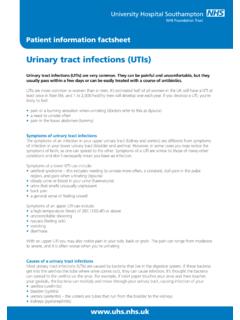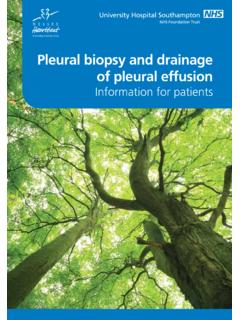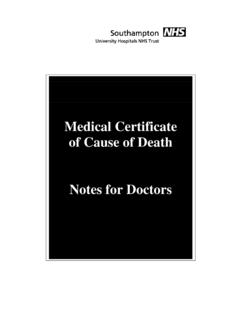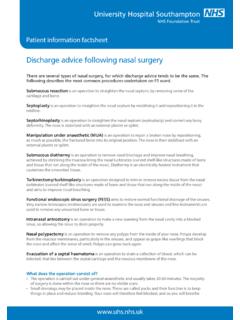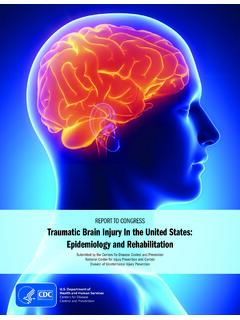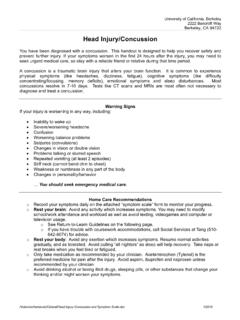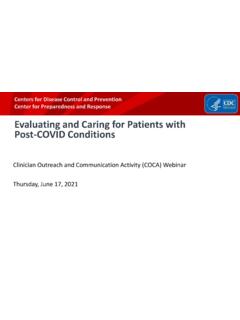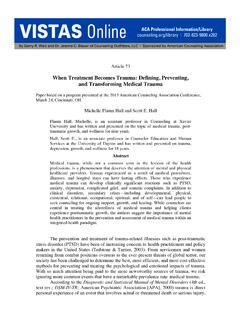Transcription of Guideline for the management of severe traumatic brain ...
1 Guideline for the management of severe traumatic brain injury during Retrieval Introduction severe traumatic brain injury is classified as a Glasgow Coma Scale (GCS) < 9. 1 million patients a year in the UK present to hospitals with head injuries, almost 50% are less than 16 years old. severe traumatic brain injuries (TBI) are a common cause of death in children in the UK, accounting for 15% of deaths in 1-15 year olds and 25% of deaths in 5-15 year olds. The most common cause is a road traffic accident followed by falls. Road traffic accidents (RTA s) account for most of the serious injuries, and 58% of all TBI deaths. In infancy, non-accidental injuries remain an important cause. Many of these patients are left with significant behavioural, cognitive, emotional and physical damage. The aims of management are to prevent secondary damage/ injury by the prevention of hypoxia, hypercapnoea, hypotension, and raised intracranial pressure.
2 It is essential that the necessary interventions are done prior to the transfer of the patient in order to reduce morbidity and mortality. The only time that a traumatic brain injured patient requires rapid transfer to a neurosurgical centre is when a mass lesion is present. Such lesions require evacuation within 4-6 hours to prevent secondary hypoxic damage. General Rules 1. All children with a GCS < 9 must be intubated and ventilated and have a CT scan performed. 2. If a child has a GCS < 9 and the plan is to keep sedated and ventilated then an intra-cranial bolt MUST be inserted. 3. If a generalised tonic/clonic seizure is thought to be the cause of the low GCS AND the CT scan is normal, these patients can be woken up at the referring hospital. 4. Adequate cerebral perfusion pressures, and adequate oxygenation, are the best modifiers of outcome in TBI. 5. Life-threatening injuries take precedence over neuro-protection.
3 6. End-tidal CO2 monitoring is essential for managing and transporting a patient with a traumatic brain injury . 7. All requests for referrals for neurosurgical assessment and management should be directed through the PICU contact number. The duty PICU consultant will liaise with the neuro-surgical registrar. 8. Space-occupying lesions and blocked ventriculo-peritoneal shunts are a neurosurgical emergency and should be transferred immediately by the referring hospital team (see appendix 4). 9. The lack of a CT scanner is a neurosurgical emergency and should mandate immediate transferral by the referring hospital team (see appendix 4). Retrieval Process 1. At Referral Call Ascertain mechanism and severity of injury . Important points to clarify are: a. Speed of impact b. Deaths at the scene c. Mechanism of injury d. Whether ejected from vehicle e. GCS at scene f. Need for cardiopulmonary resuscitation (or other interventions) at scene Ascertain clinical state of patient.
4 A. Level of Consciousness b. Pupillary response c. Abnormal posturing d. Signs of base of skull fracture Ascertain whether there are any other life-threatening injuries. Ensure patient is intubated and ventilated (indications in appendix 1). Ensure adequate fluid resuscitation (see protocol). Ensure spinal protection (see protocol). Ensure adequate neuroprotection (see protocol). Ensure no evidence of raised intracranial pressure- if there is, treat as an emergency (see protocol). Ensure child is on the way for a CT scan (indications in appendix 2). Request CT scan of C-spine if possible. Determine whether there is a neurosurgical emergency. If there is, request that the referring team brings the patient (see appendix 3 and 4). Ensure blood tests, including X-match and clotting, are performed urgently. Request referring team contacts neurosurgeons if not already done.
5 2. Pre-departure Ensure neurosurgeon aware of patient. Request they speak to referring team and view the CT scan via image-link. Request that the referring hospital radiologist formally report the CT scan. Request that the referring hospital create a CD of the CT scan for transferral. Ensure NO expanding mass lesion. If there is, referring hospital should bring the patient immediately (see appendix 4). 3. At referring Hospital Ensure adequate resuscitation (see protocol). Ensure adequate spinal protection (see protocol). Ensure adequate neuroprotection (see protocol). Ensure no evidence of raised intracranial pressure (see protocol). Ensure no life-threatening injuries. If cardiovascularly unstable and requiring >40ml/kg of fluid resuscitation, consider sites of blood loss: abdomen, pelvis, long bone fractures, chest, and head (especially in infants). DO NOT leave the referring hospital until ALL life-threatening injuries have been attended to.
6 This may mean going to theatre at the referring hospital. Ensure adequately monitored (see protocol). 4. Prior to departing Referring Hospital Ensure you have all trauma series X-rays. Ensure you have a copy of the CT scan on CD plus a hard copy if possible. Arterial blood gas prior to departure is essential to correlate PaCO2 with end-tidal CO2. All patients should have a urinary catheter placed. Ensure you have blood results (especially clotting), and X-matched blood if necessary. Ensure minimum patient monitoring: a. ECG b. end-tidal PaCO2 c. Invasive arterial pressure monitoring Protocol 1. Intubation All patients with a GCS <9 (see appendix 5) MUST be intubated. Spinal immobilisation before, during and after intubation is essential. Thiopentone is the induction agent of choice. Beware large doses of induction agent in under-resuscitated children, as they may become profoundly hypotensive.
7 Use the minimum dose required to induce anaesthesia. Suxamethonium is used if a rapid sequence induction is thought essential. Although suxamethonium is the muscle relaxant generally recommended for performing RSI, there may be circumstances where clinicians with signficant expertise in airway management may opt for the use of a modified RSI using a non-depolarising muscle relaxant. In such circumstances the balance of risk / benefit of avoidance of suxamethonium (which can increase ICP or may be contra-indicated for other reasons) must lie with the senior clinician undertaking the intubation. In principle the PICU team would support use of modified RSI if undertaken by a suitably experienced clinician. 2. Spinal Protection All patients with severe traumatic brain injury should have in-line stabilisation of their cervical spine, with removal of the collar, during intubation. Intubation of patients requires a minimum of 2 people to manage the airway (1 of which should be performing in-line immobilisation of the C-spine.)
8 Once intubated all patients must be adequately sedated and should receive a neuro- muscular paralysing agent. A hard collar, blocks and tape are essential to ensure the cervical spine is immobilised. All patients should be log-rolled to protect the thoracic and lumbar spine, if turned for any reason. All patients should be transferred on a vacuum mattress. 3. Ventilation All patients should be adequately sedated and muscle-relaxed. Patients should be ventilated to maintain a PaCO2 of kPa. All patients must have end-tidal CO2 monitoring. Maintain a PaO2 above 13 kPa or saturations 96%. It is essential to ventilate all patients with PEEP to prevent hypoxia. 4. Circulation Treat hypotension aggressively. Hypotension is the biggest cause of secondary ischaemic injury . It is essential to keep the systolic blood pressure above the 95th centile for age (see appendix 6). Every patient should have a minimum of 2 large bore peripheral cannulae or a double/triple lumen central line.
9 Avoid internal jugular lines. All patients should have invasive blood pressure monitoring. All patients must be catheterised. After a maximum of 40ml/kg resuscitation fluid, packed cells should be used for further fluid resuscitation. If cardiovascularly unstable despite fluid resuscitation, it is vital to consider other sites of bleeding, especially femur, abdomen, chest, pelvis, and in infants, the scalp. If there is ongoing bleeding, the patient should not be transferred until the bleeding has been controlled. This might necessitate the patient going to theatre in the referring hospital. The mean arterial pressure should be targeted to maintain a theoretical cerebral perfusion pressure over 60, or over 40 in infants. Noradrenaline is the preferred vasopressor unless there is evidence of myocardial dysfunction, in which case an inotrope should used in addition. 5. Neuroprotection Ensure head in mid-line position.
10 Ensure the bed/trolley is tilted to 30 degrees head up. Ensure adequately sedated (often require large amounts of morphine and midazolam) and muscle-relaxed. Maintain well oxygenated. Maintain PaCO2 at Maintain cerebral perfusion pressure greater than 60. An intracranial pressure bolt is essential for measuring pressure. It is unlikely that an ICP monitor will be sited prior to transfer, but this should not prevent awareness of the importance of maintaining an adequate cerebral perfusion pressure (CPP). Remember CPP = MAP ICP. During transfer, assume the ICP is 20 and adjust vasopressor or fluid resuscitation on this basis until an ICP device is inserted. Use noradrenaline to maintain CPP in an adequately resuscitated patient with no evidence of myocardial dysfunction. Load with phenytoin. Keep sodium >145. Use 1-2ml/kg boluses of 3% saline (see appendix 7). Maintain glucose in the normal range.



